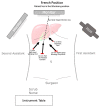Treatment of Resectable Gallbladder Cancer
- PMID: 35326566
- PMCID: PMC8945892
- DOI: 10.3390/cancers14061413
Treatment of Resectable Gallbladder Cancer
Abstract
Gallbladder cancer (GBC) is the most common biliary tract cancer worldwide and its incidence has significant geographic variation. A unique combination of predisposing factors includes genetic predisposition, geographic distribution, female gender, chronic inflammation, and congenital developmental abnormalities. Today, incidental GBC is the most common presentation of resectable gallbladder cancer, and surgery (minimally invasive or open) remains the only curative treatment available. Encouragingly, there is an important emerging role for systemic treatment for patients who have R1 resection or present with stage III-IV. In this article, we describe the pathogenesis, surgical and systemic treatment, and prognosis.
Keywords: gallbladder cancer; incidental; oncologic extended resection; resectable; treatment.
Conflict of interest statement
The authors declare no conflict of interest.
Figures




References
Publication types
LinkOut - more resources
Full Text Sources

